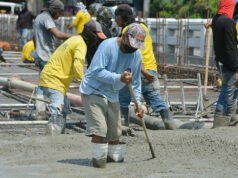Manufacturing falls for 4th month
FACTORY OUTPUT posted its fourth consecutive month of decline in March, the Philippine Statistics Authority (PSA) reported on Tuesday.
Preliminary results of the PSA’s latest Monthly Integrated Survey of Selected Industries showed the volume of production index contracting by 9.2% year-on-year in March versus the February’s revised 8.1% decline and the 11% growth logged in March 2018. It was the fourth straight month of decline following the contractions in February (-8.1%), January (-2.5%) and December 2018 (-8.9%).
Year to date, factory output decline averaged 6.6% versus the 12.3% growth in 2018’s comparable three months.
The PSA reported that eight out of 20 major industry groups registered annual declines, namely: furniture and fixtures (-25.5%), food manufacturing (-17.3%), petroleum products (-17.2%), tobacco products (-3.8%), leather products (-1.9%), non-metallic mineral products (-5.7%), basic metals (-4.6%) and electrical machinery (-1%).
In comparison, the Nikkei Philippines Manufacturing Purchasing Managers’ Index (PMI) was at 51.5 in April — the lowest in nine months — easing from February’s 51.9. A PMI reading above 50 signals improvement in business conditions from the preceding month, while a score below that point indicates deterioration.
Average capacity utilization — the extent by which industry resources are used in the production of goods — was estimated at 84.4%. Eleven of the 20 sectors registered capacity utilization rates of at least 80%.
The National Economic and Development Authority (NEDA) said in a statement that the government expects manufacturing output to rebound in the months ahead amid an increase in tourism, election-related spending and slowing inflation. “We expect the figures to improve in the coming months as we see increase in demand during summer, given the rise in the number of local and foreign tourists, easing of inflation, and increase in election-related spending. Government spending on infrastructure and other government services is also likely to catch up,” Socioeconomic Planning Secretary Ernesto M. Pernia, NEDA’s director-general, said in a statement. “However, the presence of El Niño could easily feed into a hike in power and water rates, which are essential inputs to the manufacturing sector. Fortunately, forecasts point to El Niño weakening starting May to August this year.”
“The year-on-year decline in manufacturing data may be partly brought about by higher base/denominator effects and external risk factors such as the slower global economic growth amid the lingering US-China trade war and slower economic growth in China, which partly led to slower global trade…” Rizal Commercial Banking Corp. economist Michael L. Ricafort said in an e-mail.
PSA noted that manufactured goods account for more than 80% of the country’s merchandise exports.
“Some manufacturers have been also on the sidelines amid the declining trend in both inflation and interest rates, waiting for both prices and interest rates/borrowing costs to go down further before making new investments and expansion projects,” Mr. Ricafort explained, adding that spending related to mid-term elections on Monday “could help increase business activities in industries that benefit directly and indirectly from higher election-related demand.”
University of Asia and the Pacific economist Peter Lee U said in an e-mail that the 39% volume growth in the printing subsector was “likely due to printing related to upcoming elections.”



